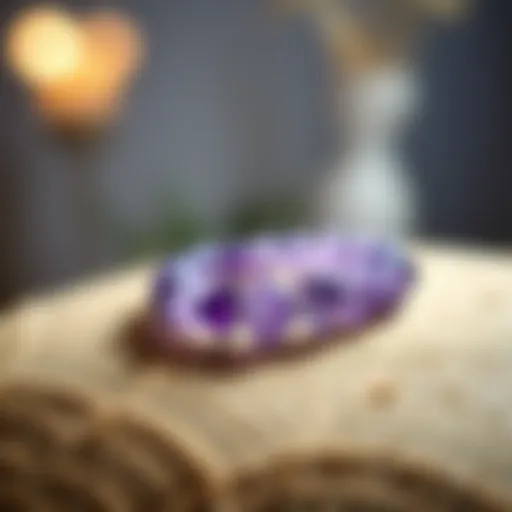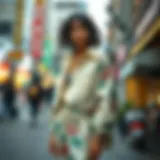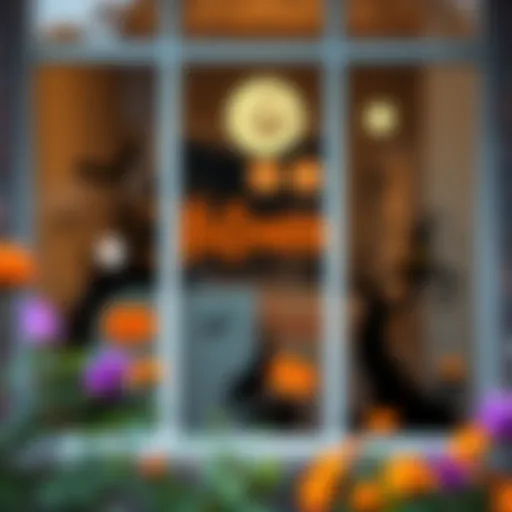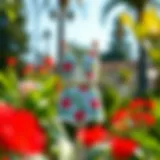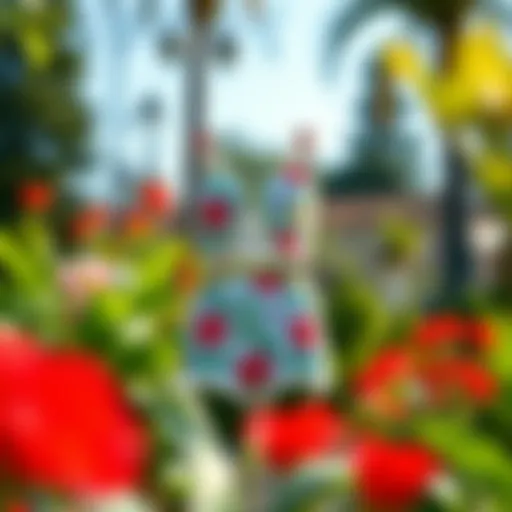Exploring Silk Sunflower Heads in Fashion Industry
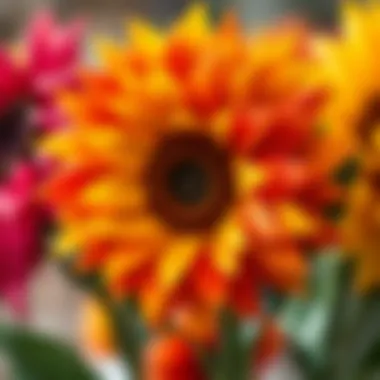

Intro
The intricate world of silk sunflower heads holds a treasure trove of possibilities, particularly within the fabric and fashion sectors. As sustainable fashion trends gain traction, understanding these unique elements becomes vital for enthusiasts, designers, and consumers alike. Silk sunflower heads blend aesthetic charm with practical applications, inviting a thorough exploration into their roles, especially in conjunction with contemporary trends and eco-conscious practices.
In this article, we dissect the layers of silk sunflower heads, delving into the manufacturing processes, design implications, and even their environmental impact. By shedding light on the beauty and versatility they bring, we aim to equip readers with the know-how to appreciate and perhaps even incorporate these elements into their fashion choices, thereby supporting a more sustainable future.
Fashion Trends
Fashion, like a shape-shifter, constantly evolves, reflecting the moods and values of society. Silk sunflower heads have emerged as a hallmark in this ever-changing arena, finding favor among a plethora of designers and fashion icons. Their vibrant hues and tactile quality add a sense of whimsy and elegance to various garments, proving that even a delicate accent can wield significant influence.
Current Seasonal Trends
In the current season, the trend is steering toward a fusion of natural elements with high fashion. Silk sunflower heads are often featured prominently on dresses, blouses, and accessories that capitalize on their vibrant appeal. Expect to see them in:
- Printed fabrics: Sunflower patterns are splashed across skirts and tops, bringing a touch of the outdoors into urban wear.
- Accessories: Flower headbands and brooches made from silk sunflower heads are turning heads, often paired with minimalist outfits to provide a delightful contrast.
- Layered looks: Designers are layering silk sunflower elements with other materials, creating rich textures that draw the eye.
Each of these applications showcases the adaptability of silk sunflower heads, allowing them to sit at the intersection of elegance and casual wear, ensuring that they appeal to a diverse range of consumers.
Influential Style Icons
When it comes to style, icons can shape trends almost single-handedly. Celebrities like Zendaya and Rihanna have been spotted donning designs that incorporate silk sunflower heads, further elevating their status in the fashion world. Through their choices, these figures not only set the tone for what’s in vogue but also enhance the visibility of sustainable fashion practices. They highlight how these seemingly small elements can pack a punch in any outfit, making them essential for today's fashion enthusiasts.
"Fashion is all about change, and silk sunflower heads are leading the way by embodying vibrant beauty without sacrificing sustainability."
Sustainable Practices
As consumers become more discerning, the demand for ethical and sustainable materials continues to rise. Silk sunflower heads fit pertinent criteria for eco-friendly fashion, marking a shift away from fast fashion towards a more considerate approach.
Eco-friendly Fabrics
Silk itself is often lauded for its luxurious feel and aesthetic versatility, but not all silks are created equal. When sourced ethically, silk sunflower heads can serve as a sterile canvas for sustainable practices. The process of crafting silk into fabric involves methods that can be tailored to minimize environmental footprints, sometimes involving:
- Natural dyeing techniques: Avoiding harmful chemicals and using plants, food waste, or minerals to create colors organically.
- Water conservation methods: Implementing practices that ensure the least amount of water is used while maintaining quality.
- Biodegradable finishing: Opting for methods that do not leave harmful residues post-wear.
Ethical Fashion Brands
Various brands are stepping up to the plate, integrating silk sunflower heads into their offerings while adhering to ethical practices. Companies like Reformation and Patagonia emphasize transparency and sustainability, ensuring their products reflect their commitment to the environment. By supporting these brands, consumers can make choices that align with a broader movement towards responsible fashion, thereby contributing to a sustainable future.
Exploring the journey of silk sunflower heads reveals their multifaceted nature and relevance in the current fashion landscape—it's a journey worth taking for anyone passionate about style, sustainability, and innovation.
Prelude to Silk Sunflower Heads
Silk sunflower heads have emerged as a significant element in fashion and design, combining both aesthetic appeal and practical functionality. These items have carved a niche for themselves in various applications, underscoring their increasing relevance in contemporary style. Understanding the intricacies of silk sunflower heads is crucial for fashion enthusiasts, designers, and consumers who appreciate nuanced details in their sartorial choices.
Definition and Importance
Silk sunflower heads refer to crafted decorative elements made from silk that mimic the appearance of real sunflower blooms. Unlike their natural counterparts, these artificial flowers are designed to retain their beauty indefinitely, making them an attractive choice for fashion and home decor. The appeal of silk sunflower heads lies not only in their lifelike appearance but also in their versatility. They can be used in clothing, accessories, or interior designs, allowing for a range of creative expressions.
The importance of silk sunflower heads extends beyond mere decoration. In the realm of sustainable fashion, these silk creations offer an eco-friendly alternative to real flowers, eliminating concerns around withering or contamination from pesticides. As consumers become more environmentally conscious, the demand for durable and sustainable fashion elements like silk sunflower heads only continues to grow.
Historical Context
The history of silk sunflower heads is rooted in an appreciation for both floral motifs and the use of silk in decorative arts. Silk, prized for its luxurious feel and sheen, has a long-standing role in textile history. Its use in making artificial flowers can be traced back to the 18th century, where they served both decorative and symbolic purposes.
"The use of artificial flowers rose significantly during the Victorian era, where they became a fashionable accessory and were often incorporated into elaborate costumes and household decor."
The concept of replicating flowers has evolved, but the silk flower craft, particularly sunflower heads, gained notable traction during periods of industrialization when mass production allowed for greater accessibility. Over the decades, these creations have transitioned from luxury decor items reserved for the elite to commercially available items embraced by the average consumer. It is during this transformation that silk sunflower heads found their way into everyday fashion, blending tradition with modern trends.
In summary, tracing the evolution of silk sunflower heads offers insights into how they not only reflect cultural changes but also satisfy contemporary needs for longevity, sustainability, and aesthetic enjoyment.
Manufacturing Process
The manufacturing process of silk sunflower heads is a pivotal component in understanding their role and impact within the fabric and fashion industry. This section elaborates on not only the operational side but also the importance of sustainable practices. By grasping how silk sunflower heads are made, designers and consumers alike can appreciate their value and advocate for eco-friendly choices in their purchases. The process influences the quality, durability, and aesthetic appeal of the final product, supporting a shift towards more sustainable fashion practices.
Sourcing Raw Materials
Getting the right materials is half the battle when it comes to manufacturing silk sunflower heads. The initial step involves the careful selection of raw silk fibers. These fibers are usually sourced from silkworms, but additional materials, such as dyes and adhesives, are also crucial in creating a vibrant and long-lasting product.
- Sustainability Considerations: Sourcing materials that are eco-friendly is essential. Many brands now opt for organic silk that is dyed using natural pigments. These choices not only reduce the environmental impact but also appeal to increasingly aware consumers who prioritize sustainability.
- Quality of Silk: The quality of the silk fibers directly impacts the final look and feel of the sunflower heads. Suppliers who focus on ethical practices tend to offer higher quality silk that is soft yet robust, preventing it from degrading over time.
- Regional Variations: Interestingly, different regions have unique methods of silk production. For example, silk from China might differ in texture and sheen when compared to Indian or Thai silk, shaping how designers select materials for their creations.
Once raw materials are obtained, the next phase can begin, transforming these resources into the beautiful silk sunflower heads that find their way into our wardrobes and home decor.
Production Techniques
Manufacturing silk sunflower heads involves a variety of intricate production techniques. This process requires skilled craftsmanship, as well as an understanding of both traditional and modern methods of fabrication.
- Handcrafted Techniques: Many artisans prefer to create silk sunflower heads by hand. This meticulous approach allows for unique details and variations that can make each piece a little bit special. Artisans often use traditional weaving methods that have been passed down through generations, lending a cultural touch to the final product.
- Machine Production: On the other side, larger manufacturers utilize machines to mass-produce silk sunflower heads. This method is cost-effective and ensures consistency in the products. Modern machinery can replicate intricate details and make the production process faster, meeting the demands of the fashion industry.
- Sustainability in Production: During production, eco-conscious practices play a crucial role. Techniques like waterless dyeing and energy-efficient machinery minimize the environmental footprint. Brands that implement these tactics not only improve their sustainability profile but also resonate well with consumers who are conscious of their purchases.
- Finishing Touches: After the basic form of silk sunflower heads is constructed, additional steps like dyeing and shaping are performed. These finishing touches refine the look and ensure that the sunflower heads can withstand use in various applications, from fashion accessories to home decor.
In summary, the manufacturing process of silk sunflower heads encompasses a wide range of practices from sourcing to techniques used during production. Understanding this complexity provides valuable insight into the effort invested in each beautiful piece, ultimately fostering a greater appreciation in consumers and designers alike.
"The quality of the materials and the techniques of production are what separate the great designs from the mediocre ones."
To learn more about the world of silk and its production, you may explore additional resources like Encyclopedia Britannica or delve into academic studies available at University Research. Make sure to keep this information close at hand, as the nuances of silk production will continually evolve alongside fashion trends.
Design Applications
The realm of design applications for silk sunflower heads proves to be a compelling aspect of their overall significance within the fabric industry. The flexibility offered by these unique materials transcends basic aesthetic appeal; it intertwines with creative expression and functional utility. With the heightened interest in eco-friendly options and novel design solutions, the versatility inherent in silk sunflower heads positions them as vital components across various fields, particularly in fashion and home decor.
Fashion and Textile Design
In the world of fashion and textile design, silk sunflower heads offer a fresh burst of creativity. Designers harness the vibrant colors and intricate textures of these artificial flowers to craft statements that capture attention. They can serve as focal points on garments, adding dimension and intrigue to otherwise simple designs. For example, a silk sunflower head affixed to the shoulder of a dress can transform a classic silhouette into something eye-catching. The flowers can also be woven into fabric, aligning with the trend towards more dynamic textile patterns that resonate with consumers seeking individuality.
Moreover, the lightweight nature of silk fungi makes them an ideal choice for accessories. Consider the impact of silk sunflower brooches or hairpieces at events. These pieces not only elevate an outfit but also speak volumes about the wearer's style philosophy. They resonate with the current desire for sustainable fashion alternatives, marrying beauty with environmental consciousness.
One can also observe that silk sunflower heads enable unique branding opportunities. Designers and brands looking to differentiate themselves can create signature looks that incorporate these floral elements. It's not just about selling clothes; it's about storytelling. Here, it’s about weaving together threads of culture, tradition, and innovation through each handcrafted piece. This narrative quality can appeal immensely to a demographic that thrives on meaningful consumption.
Home Decor Innovations
The application of silk sunflower heads extends well beyond the boundaries of clothing and accessories. In home decor, they find a canvas like no other. Their realistic appearance makes them suitable for various settings, from cozy residential spaces to upscale commercial venues. Silk sunflower arrangements can be key assets in interior design, providing splashes of color that enliven spaces without the upkeep of natural flowers. For instance, incorporating them into a centerpiece can significantly impact dining aesthetics, making tables not just functional but also vibrant.
In seasonal decor, silk sunflower heads can be stationed beautifully during harvest festivals or autumn-themed displays. They lend themselves well to various design schemes, whether modern minimalism or rustic charm.
Here’s a brief rundown of how they can be utilized:
- Wreaths and Garlands: Ideal for door and wall adornments during various seasons.
- Table Settings: Create eye-catching arrangements that add warmth and style.
- Wall Art: A gallery of silk sunflower heads can serve as a striking alternative to traditional art.
- Event Decorations: From weddings to corporate events, these florals can set the tone without the fuss of live arrangements.
In its versatility, silk sunflower heads emerge as quintessential elements for bringing a touch of nature indoors, minus the hassle.
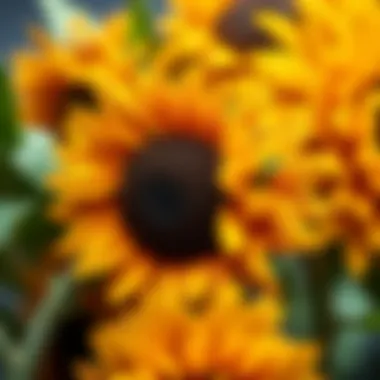
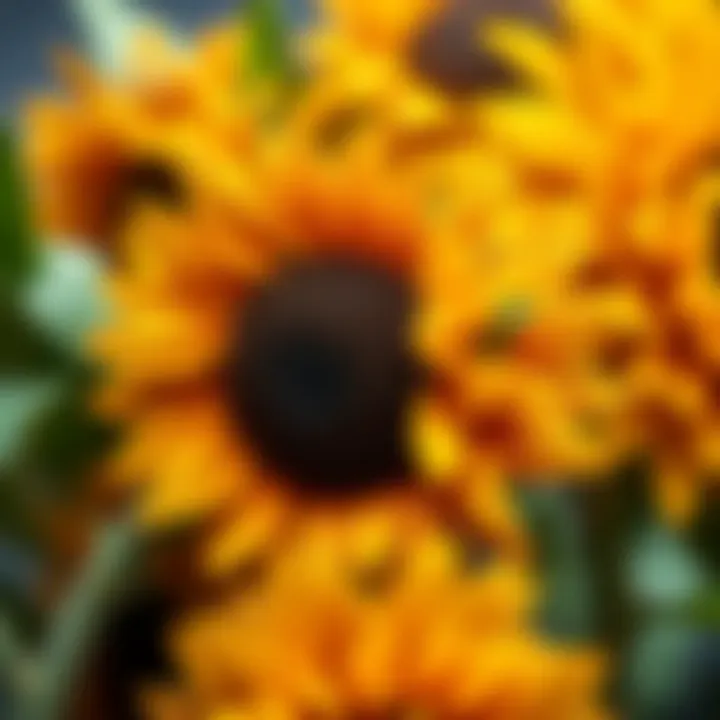
As sustainability becomes a buzzword in home decor, opting for silk versions over natural flowers means a longer-lasting aesthetic that does not wither with time. This not only caters to the practical needs of decor enthusiasts but also echoes a commitment to responsible choices. Consumers today are looking for items that marry taste with environmental awareness, and silk sunflower heads fit this bill perfectly.
Aesthetic Qualities
In the realm of fashion and design, the aesthetic qualities of materials can make all the difference. When it comes to silk sunflower heads, their allure manifests through a combination of visual appeal and textural characteristics that elevate them far beyond just a decorative element. Understanding these attributes is paramount for designers and consumers alike, as they influence choices in everything from clothing to home decor. Not only do silk sunflower heads imbue projects with a sense of elegance and charm, but they also possess nuances that can cater to a variety of styles and settings.
Visual Appeal
Silk sunflower heads capture attention with their vibrant colors and life-like forms. They can mimic the stunning hues of nature, from brilliant yellows and deep browns to soft golds, offering a veritable feast for the eyes. This visual allure is one reason they’re frequently used in fashion collections and interior design. Designers often use these floral accessories to create focal points or to add a splash of color that brightens an ensemble.
"The visual impact of silk sunflower heads in fashion is like having a garden in bloom, enhancing the aesthetic landscape without the constraints of seasonal change."
The adaptability of silk sunflower heads makes them suited for various styles. From bohemian chic to classic elegance, the color palette is rich enough to complement almost any aesthetic vision. By adding silk sunflower heads to a fashion piece or decor item, one can achieve a sophisticated charm that roots itself firmly in the beauty of nature while remaining polished and enduring.
Textural Characteristics
Textural attributes are equally significant when analyzing the aesthetic qualities of silk sunflower heads. The smooth surface and delicate structure lend them an air of sophistication, which stands in contrast to rougher, more organic materials. This feature not only adds complexity but also enhances tactile interaction, inviting one to touch and engage with the fabric.
Unlike natural flowers, which wilt and fade, silk sunflower heads maintain their texture. This durability translates to longevity in design applications, providing a consistent texture that upholds the intended aesthetic across time.
- Softness: The gentle, soft feel of silk contrasts beautifully with the rigidity often found in other materials, promoting a luxurious experience.
- Layering Possibilities: Their lightweight texture enables artists and designers to layer them gracefully, creating depth and enhancing visual storytelling.
- Movement: When fashioned into garments or decor, the slight movement of silk sunflower heads can evoke feelings of whimsy and grace, akin to a gentle breeze through a blooming garden.
Ultimately, the delicate nature and textural sophistication of silk sunflower heads encourage creativity in design. Their capability to captivate both visually and tactically enables an endless range of applications, making them a staple in modern aesthetics.
Cultural Significance
Understanding the cultural significance of silk sunflower heads provides a window into how a simple fabric element can embody deep meanings and various applications across the globe. In many cultures, sunflowers are symbols of adoration, loyalty, and longevity. Thus, when one considers silk sunflower heads, it becomes clear they extend beyond mere aesthetics; they become vessels of interpretation and sentiment within numerous contexts.
Symbolism in Different Cultures
Across various cultural landscapes, sunflowers can carry differing connotations, often rooted in local history, folklore, and aesthetics. For instance, in many Native American cultures, the sunflower has been celebrated as a symbol of abundance and harvest, signifying nourishment as it is often associated with the sun's life-giving properties.
In contrast, in Chinese culture, sunflowers are seen as a representation of good luck and happiness. During festivals, they might be prominently displayed, capturing the vivid energy and warmth akin to their natural counterparts under the glowing sun. The use of silk sunflower heads, with their vibrant hues and intricate designs, serves to deepen this cultural resonance, often becoming integral to celebrations and significant occasions.
Moreover, in modern contexts, silk sunflower heads resonate within the fashion and craft industries, where they are employed to create eye-catching designs infused with cultural narratives. For example, a garment made with silk sunflower elements might be intended to embody a sense of joy and positivity, drawing upon its cultural associations. Here’s a list of how these symbols are interpreted:
- Abundance: Reflecting nature's richness, especially in Native American references.
- Happiness: Often portrayed in Asian cultures as a motif for joyful occasions.
- Loyalty: Seen in various traditions where sunflowers represent steadfastness.
In summary, silk sunflower heads are not merely decorative; they weave a rich tapestry of meaning that transcends their physical form, enhancing garments and crafts with deeper stories.
Applications in Art and Craft
Silk sunflower heads also hold significant value within the realm of art and craftsmanship. Artists and crafters utilize these luxurious fabric flowers in a variety of applications. From innovative designs in fashion to stunning pieces of home decor, the versatility of silk sunflower heads is remarkable.
Often, artisans incorporate silk sunflower heads into mixed-media projects, merging textiles with other materials to create thought-provoking art. The tactile nature of silk coupled with the visual impact of sunflower motifs inspires many creators to explore new dimensions. For instance:
- Wearable Art: Designers often integrate silk sunflower heads into clothing, accessories, and statement jewelry pieces, bringing a touch of nature into everyday wear.
- Home Decor: These fabric creations are utilized in wreaths, centerpieces, and wall art, bringing color and life to interiors.
- Upcycled Projects: Many crafters are repurposing old garments by adding silk sunflower heads, transforming something outdated into a fashionable statement.
Sustainability Factors
Sustainability has become a pressing concern in recent times, especially in the fashion industry. The use of silk sunflower heads symbolizes an evolution towards considering ecological impacts. This section delves into the importance of sustainability factors, particularly focusing on how silk sunflower heads contribute positively to environmental health and what this means for the fabric and fashion sectors.
Eco-Friendly Production Practices
To establish a sustainable presence in the market, the production of silk sunflower heads emphasizes eco-friendly practices. Here are a few aspects to consider:
- Sourcing Responsible Materials: The raw materials for silk sunflower heads are often sourced from suppliers committed to sustainable agriculture. By opting for non-toxic dyes and organic fibers, producers minimize harm to the environment.
- Reduced Water Usage: The tailored manufacturing processes developed for silk sunflower heads usually rely on water-efficient techniques. This means fewer resources are consumed compared to traditional flower production.
- Minimal Waste Generation: Many manufacturers have adopted practices that prioritize waste reduction. This can take the form of recycling scraps or reusing materials in other projects, aligning operational practices with ecological objectives.
The benefits of eco-friendly production are clear. Not only do they mitigate environmental footprints, but they also appeal to a growing market of socially responsible consumers who look for products that reflect their values.
Lifecycle Assessment
A comprehensive lifecycle assessment (LCA) evaluates the overall impact of silk sunflower heads from sourcing to disposal. Understanding this cycle can offer insights into areas for improvement and refinement. Here are key points considered in an LCA of silk sunflower heads:
- Raw Material Extraction: The initial phase involves understanding the impact of sourcing silk fibers and other materials used in creating sunflower heads. Sustainable sourcing can maintain biodiversity and protect ecosystems.
- Production Impact: This phase examines energy consumption, emissions, and resource use during manufacturing. Efficient practices and renewable energy sources can significantly lessen a product’s carbon footprint.
- Distribution Considerations: Transportation contributes to environmental impact. Evaluating distribution channels with an eye towards efficiency and reduced emissions can further enhance sustainability efforts.
- End-of-Life Analysis: Finally, understanding how silk sunflower heads are disposed of involves examining options for recycling or composting. Should they end up in landfills, the environmental cost escalates.
Ultimately, a thorough LCA provides valuable data informing manufacturers and designers about which practices to keep and where they may yet improve.
By harnessing eco-friendly practices and conducting rigorous lifecycle assessments, the silk sunflower head industry can continue to thrive within the framework of sustainability.
For further reading on the significance of sustainable manufacturing processes, consider checking resources from EPA or Sustainable Fashion Resource.
Sustainability is not merely a trend but a necessity, and by focusing on these aspects, the silk sunflower head's place in fashion can be both stylish and ecologically responsible.
Market Trends
When navigating the intricate realm of silk sunflower heads, understanding market trends is akin to possessing a compass in uncharted waters. The significance of this topic cannot be overstated, as it shapes consumer preferences and consequently influences the wider fashion landscape. Not only do market trends dictate what’s in vogue, they also reflect underlying cultural shifts and consumer values like sustainability, elegance, and creativity.
Current Trends in Fashion
In recent years, silk sunflower heads have carved a unique niche within the fashion industry, gaining traction for their versatility and aesthetic appeal. Designers increasingly lean toward these fabric accents, employing them in various fashion items ranging from upscale dresses to chic accessories.
Some noteworthy trends include:
- Sustainable Fashion: There’s a growing consumer demand for eco-conscious materials. Silk sunflower heads, often produced using sustainable practices, resonate with environmentally-aware shoppers, providing an attractive alternative to synthetic materials.
- Bold Patterns and Colors: Presently, bold and vibrant designs incorporate silk sunflower heads, allowing wearers to express their individuality. Shades of yellow and gold, reminiscent of real sunflowers, dominate seasonal palettes.
- Layering Techniques: Layering silk sunflower heads in apparel and accessories is becoming all the rage. This technique adds depth and dimension to outfits, creating striking visual compositions.
"Silk sunflower heads symbolize a blend of nature and artistry, making a profound statement in modern fashion."
Such trends are essential to track, as they inform what consumers are purchasing. Designers and brands are refining their collections based on these blowouts, accommodating buyers' preferences and aspirations.
Future Projections
As we peer into the crystal ball of fashion, several projections emerge regarding silk sunflower heads and their integration into upcoming trends. The future appears promising, with possibilities influenced by technology, craftsmanship, and social movements.
- Digital Fashion: The rise of digital environments presents new opportunities for silk sunflower heads. Augmented reality and virtual fashion shows could revolutionize how these items are presented. Imagine a world where you can visualize silk sunflower heads on an avatar before purchasing.
- Increased Customization: Tailored designs are on the horizon. Consumers increasingly favor customization, allowing them to select specific motifs or patterns for silk sunflower heads that resonate with their personal style.
- Global Influence: As international design influences mingle, expect to see unique interpretations of silk sunflower heads that borrow from diverse cultural elements, creating a rich tapestry of fashion options.
The intersection of these trends will heavily influence market dynamics as brands strive to stay relevant and appealing. Keeping an ear to the ground, stakeholders can align themselves with the pulse of the industry, navigating through present intricacies toward future success.
Consumer Preferences
When diving into the world of silk sunflower heads, understanding consumer preferences becomes crucial. The way people gravitate towards these unique pieces in fashion and decor reflects deeper insights into the current market. Consumers today are not just looking for products; they are searching for trends that resonate with their lifestyle, values, and aspirations. This section aims to unravel these dimensions by examining who the buyers are and how social media plays a pivotal role in shaping their choices.
Buyer Demographics
Buyer demographics shed light on the variety of individuals engaging with silk sunflower heads. Knowing who these consumers are helps brands tailor their offerings effectively. The primary demographic consists of young adults aged 18 to 35, who show a marked interest in sustainable fashion. This group often prioritizes eco-friendliness alongside style.
Apart from this, older consumers, particularly those in their 40s to 60s, often gravitate towards silk sunflower heads for home decor, appreciating their timeless elegance. The breakdown includes:
- Age: Predominantly 18-35, with a secondary focus on 40-60.
- Gender: While predominantly female, there’s an increasing interest from male consumers.
- Income Level: Middle to upper-middle class, indicating a willingness to invest in quality.
- Location: Urban areas are more prominent, where fashion trends circulate swiftly.

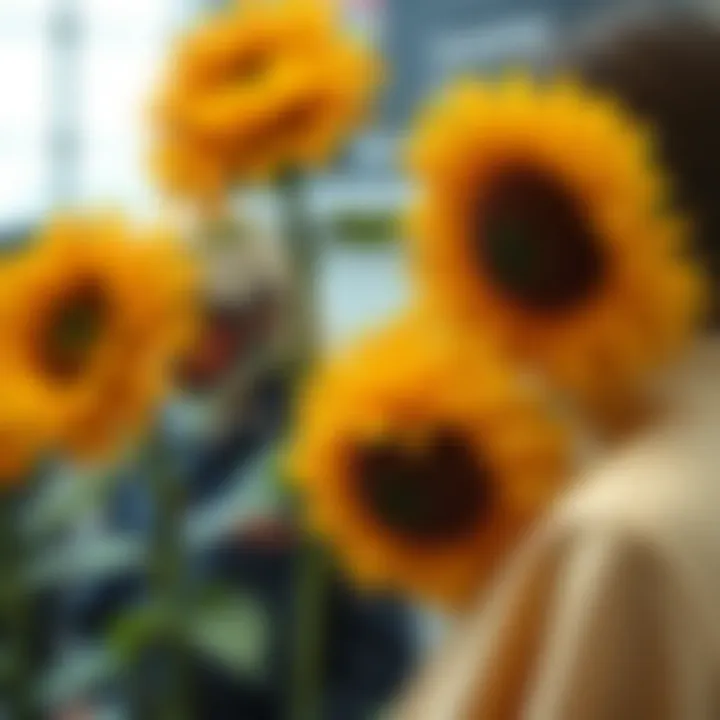
This variety in demographics indicates that silk sunflower heads are not just a passing trend but a versatile option that appeals to different tastes and needs.
Influence of Social Media
The role of social media in consumer preferences can't be understated. Platforms like Instagram and Pinterest have become powerful tools for trendsetting, shaping how consumers perceive silk sunflower heads. Visual appeal reigns supreme here, with a single eye-catching photo potentially driving sales.
Social media influencers play a significant role in this ecosystem. They curate content that highlights the beauty and versatility of silk sunflower heads, making them desirable.
"A picture speaks a thousand words; a well-placed silk sunflower head can change the tone of an entire room or outfit."
- Trends: Posts featuring silk sunflower heads in innovative ways can create instant demand, pushing users to explore purchase options.
- Engagement: Likes, comments, and shares can create a ripple effect, driving awareness and interest.
- Community: Platforms facilitate communities focused on sustainable fashion, where silk sunflower heads find a prominent mention in discussions.
In wrapping up this section, it's evident that consumer preferences for silk sunflower heads are shaped by a blend of age, gender, income, and the undeniable sway of social media. This multifaceted approach can help brands connect with their target audience effectively, ensuring that they resonate with the evolving landscape of fashion.
Practical Uses
Silk sunflower heads serve various practical uses that elevate their appeal beyond mere decoration. Understanding these applications enriches our appreciation of their role in the fashion and decor industries. Their versatility transforms both everyday wear and special occasions into unique experiences that reflect style and personality. From everyday fashion choices to elaborate event decor, these silk creations offer lasting value alongside aesthetic benefits.
Daily Fashion Applications
Silk sunflower heads find their way into fashion in numerous innovative ways. They are often used as accessories, reimagining classic forms like hair clips, brooches, or even in headbands. These elements can effortlessly elevate a simple outfit, turning a casual ensemble into something striking with just a few well-placed sunflower accents.
For example, consider a plain denim jacket that sits in the back of your closet. Adding a silk sunflower brooch can transform it into a statement piece, perfect for brunch or a casual gathering. Similarly, silk sunflower clips can add a playful note to a ponytail or bun, giving off a vibrant and youthful energy. The lightweight nature of silk ensures that these accessories remain comfortable, allowing for all-day wear without discomfort.
Silk sunflower heads also find their home in custom-designed garments. Designers often incorporate these floral accents into dresses or tops, creating a unique visual appeal that stands out in crowded fashion markets. With sustainable fashion gaining traction, many fashion enthusiasts are turning toward these silk elements as eco-friendly choices, resonating with the growing consumer demand for conscious purchasing.
A true standout in fashion is not only about what you wear, but how you wear it. Adding silk sunflower heads is one way to express individuality and creativity in everyday choices.
Event Decor
Events often hinge on aesthetics, and silk sunflower heads can transform the ambiance of any occasion. Whether it’s a wedding, birthday party or corporate event, these floral installations are like icing on the cake. They embody not only the theme but also the emotional tone of the gathering.
For instance, wedding planners frequently use silk sunflower heads in centerpieces, bouquets, and wreaths. They can be arranged alongside other flowers, or stand alone to achieve a stunning, minimalist look. The permanence and durability of silk mean that these arrangements remain beautiful throughout the day, without wilting or fading as natural flowers do.
Additionally, using silk sunflower heads for event decor can be both financially practical and sustainable. They can be reused or resold, reducing waste and expenses for future events. This aspect appeals to environmentally conscious planners who wish to leave a lighter footprint in their celebrations while keeping the beauty intact.
- Versatile Uses in Event Decor:
- Centerpieces for tables
- Flower crowns for bridesmaids
- Wall installations or backdrops
- Decorative details on invitations and gifts
Comparative Analysis
Understanding the comparative analysis between silk sunflower heads and their natural counterparts not only broadens our understanding of material qualities but also enhances the decision-making process for consumers and designers alike. This section endeavors to dissect key elements such as versatility, aesthetic appeal, maintenance demands, and the sustainability implications associated with both options. As the world pivots toward sustainable practices, the importance of drawing a contrast between silk sunflower heads and natural flowers cannot be overstated, particularly in fashion and decor industries where such choices can make or break a design strategy.
Silk Sunflower Heads vs. Natural Flowers
When pitting silk sunflower heads against natural flowers, several important factors emerge. The most immediate difference is visual. Silk sunflower heads often boast consistent colors and shapes that can be visually striking, allowing for a polished look that natural flowers sometimes lack due to their inherent variability. The natural flower's beauty can be enchanting, but it often comes with flaws—uneven petals, browning edges, or wilting, all elements that can detract from their appearance.
However, it’s not just about looks. Durability is another significant advantage of silk sunflower heads. Unlike natural flowers, which wilt and fade over time, silk versions retain their vitality for years. This characteristic makes them a preferred choice for events, where the ambiance is crucial. Just think about that big wedding or themed party where everything has to be perfect. Not having to worry about replacing wilting flowers saves time and hassle.
However, some argue that nothing can replicate the sensory experience of a fresh flower—the scent and tactile sensation of genuine petals are lost with artificial alternatives. Plus, natural flowers contribute to the environment in ways silk cannot. They provide oxygen, support pollinators, and nourish soil, imbuing them with ecological value. The aromatic experience of natural flowers, rich in volatile compounds, also adds to their charm, providing a sensory delight that silk simply cannot replicate, which may act as a decisive factor for some consumers.
In regards to price, natural flowers can turn out to be an unpredictable expense. Prices fluctuate based on the season, availability, and location. On the other hand, silk sunflower heads provide cost stability over time since they can be purchased once and reused multiple times without the issues of spoilage.
Considering a side-by-side analysis can yield valuable insights for individuals and designers. Below are summarized points of comparison:
- Visual Appeal
- Durability
- Environmental Impact
- Cost Stability
- Silk Sunflower Heads: Consistent and striking, free from imperfections.
- Natural Flowers: Unique but often flawed, requiring meticulous selection.
- Silk Sunflower Heads: Long-lasting and resilient.
- Natural Flowers: Short-lived, typically lasting a few days.
- Silk Sunflower Heads: Minimal ecological contribution.
- Natural Flowers: Support ecosystems and provide oxygen.
- Silk Sunflower Heads: One-time investment, reusable.
- Natural Flowers: Price fluctuates based on market conditions.
In summation, the silk sunflower heads present an appealing option for many, while the natural flowers still hold an irreplaceable charm. The choice between these two hinges on context, preference, and the specific needs of the buyer.
Fabric Durability Comparison
When it comes to fabric durability comparison, the longevity of silk sunflower heads contributes significantly to their allure as a choice for consumers. Unlike natural flowers, which lose their essence over time, silk versions maintain their appearance and structural integrity for extended periods. The durability of silk is often a game changer for those in the fashion and decor industries, where the longevity of materials can dictate success.
Silk, made from fibers produced by silkworms, is notably strong. Its tensile strength is comparable to that of steel on a per-weight basis. When engineered into designs, silk sunflower heads can withstand wear and fade far better than their natural counterparts. In contexts like clothing or event decorations, the ability to repeat use without loss of quality is essential.
To encapsulate this distinction, consider the following points:
- Strength and Resilience:
Silk's fibers are incredibly strong and maintain their shape over time, even in the face of environmental factors like humidity. - Maintenance and Care:
Silk sunflower heads only require simple cleaning—just a gentle wipe with a damp cloth—while natural flowers require regular watering and special handling to avoid wilting. - Seasonal Variability:
Natural flowers are subject to seasonal changes whereas silk heads are available year-round, providing consistent choices regardless of the time of year.
"In fashion, material choice isn't just about aesthetics—it's about the story you want to tell and the impact you want to leave behind."
This comparative analysis not only highlights the nuanced differences between silk sunflower heads and natural flowers but also underscores the broader implications of material selection in fashion and decor.
Challenges in the Industry
The silk sunflower head industry is not without its obstacles. Whether you're a designer, consumer, or part of the manufacturing process, understanding these challenges is key to navigating the nuances of this intriguing fabric element. Issues like supply chain complexities and quality control can significantly impact production efficiency, product pricing, and ultimately, consumer satisfaction. As the industry leans towards sustainable practices, overcoming these hurdles becomes increasingly important.
Supply Chain Issues
Supply chains are the backbone of the silk sunflower head market. When everything clicks smoothly, the process might seem seamless. However, disruptions can throw a wrench into the works, causing everything from production delays to inflated costs. Here are some noteworthy factors that contribute to these challenges:
- Sourcing Raw Materials: The availability of quality silk and natural dyes can fluctuate based on economic and environmental conditions. For example, when silk prices spike due to reduced harvests, manufacturers are often left scrambling to find alternatives or adjust their pricing strategies.
- Regional Complexity: Different regions may have regulations affecting trade and logistics. A shipment stuck in customs or facing tariffs can delay an entire line of products. For instance, if a company relies on silk sourced from Asia, any geopolitical tensions could cause significant delays in access to those materials.
- Transportation Fluctuations: Global events such as pandemics or natural disasters directly affect transport routes. A vital shipping lane might close, resulting in longer delivery times and increased costs, which could alienate customers eager for timely fashion trends.
Quality Control Concerns
When it comes to silk sunflower heads, maintaining quality is non-negotiable. The connection between quality and customer satisfaction cannot be overstated—issues here can undermine an entire brand's reputation. Key quality challenges include:
- Inconsistency in Materials: Variations in silk fibers due to differing farming practices or processing methods can lead to inconsistent product quality. Fabrics that don't meet high standards can result in products that wear out prematurely, leaving consumers disappointed.
- Manufacturing Flaws: Even if raw materials are top-notch, the production process has its pitfalls. A slip-up in dyeing, cutting, or stitching could compromise the overall aesthetic and structural integrity of the silk sunflower heads, impacting marketability.
- Inspection and Feedback Loops: Establishing robust quality assurance processes often falls by the wayside. In a rush to meet deadlines, companies might overlook the necessary inspections. It’s imperative for brands to implement effective feedback loops, allowing them to address issues proactively rather than reactively.
"Quality is not an act; it is a habit." - Aristotle
Navigating these challenges requires agility and foresight. By acknowledging and addressing supply chain issues and quality control concerns, stakeholders can create a resilient silk sunflower head industry that prioritizes both innovation and sustainability, aligning perfectly with fashion-forward consumers.
Case Studies
Exploring case studies in the realm of silk sunflower heads provides a deeper understanding of how this versatile material is used and valued across the fashion and design industry. These examples serve to illustrate real-world applications, successes, and sometimes challenges that brands face while incorporating silk sunflower heads into their collections or projects. In a rapidly evolving market, identifying successful strategies can be incredibly beneficial for aspiring designers and enthusiasts. By examining specific brands and individuals, we can glean valuable insights into the creative potential this fabric offers.
Successful Brands Using Silk Sunflower Heads
Several prominent brands have adeptly harnessed the charm of silk sunflower heads, weaving them into their lines to not only enhance aesthetics but also to align with environmental practices. For example, Anthropologie, a well-known retailer, has embraced these vibrant blooms in home decor and accessory designs. They utilize rich colors and nuanced textures to create pieces that resonate with a bohemian vibe, effectively appealing to a diverse consumer base.


Another noteworthy mention is Macy’s, which has utilized silk sunflower heads in various seasonal product lines, especially around autumn. Their marketing strategy capitalizes on the natural beauty associated with sunflowers, attracting customers wishing to bring a touch of warmth and cheer into their homes. This brand showcases a blend of traditional floral elegance with modern design flourishes, emphasizing accessibility while maintaining quality—both essential aspects in today’s market.
The incorporation of silk sunflower heads is not just about aesthetics; it's a statement of sustainable fashion choices.
Here’s a quick look at what these successful brands highlight:
- Aesthetic Appeal: Use of vibrant colors and diverse textures.
- Market Strategy: Seasonal and trend-based marketing that resonates with target customers.
- Sustainability: An emphasis on eco-friendly practices that attract environmentally conscious consumers.
Innovative Artisans and Designers
Beyond the established brands, many artisans and independent designers are making waves with their innovative approaches to silk sunflower heads. For example, Elowen Creations, a small craft business, specializes in using silk sunflower heads to create one-of-a-kind jewelry pieces. They experiment with different styles, infusing a touch of nature into wearable art. This hands-on approach not only promotes individuality but also encourages an appreciation for sustainable creativity.
On the other side of the spectrum, Molly K is a designer who has gained attention for her avant-garde fashion line incorporating silk sunflower heads into garments. Her designs challenge conventional views, showing how this material can transcend traditional uses and create high-end runway pieces that speak to current trends in the fashion world. By layering silk sunflower heads with other fabrics, she crafts unique textures that captivate fashion enthusiasts.
Artisans and designers like Elowen Creations and Molly K are at the forefront, demonstrating:
- Creativity: Innovative applications that push boundaries in design.
- Personalization: Focusing on unique offerings that resonate with customers seeking individuality.
- Artisan Techniques: Incorporating craft-oriented methods that elevate the role of silk sunflower heads in modern design.
In summary, the case studies presented illustrate the diverse applications and successful integrations of silk sunflower heads in both established brands and independent creators. The landscape continues to expand as sustainability and aesthetics converge, inviting new ideas and artistic expressions within the fashion and design spaces.
Expert Opinions
The perspective of experts in the silk sunflower heads domain adds a significant layer of understanding to this article. Their insights not only enhance the credibility of the presented information but also illuminate the nuances that drive the markets and design decisions surrounding this unique fabric element. Through expert opinions, readers are positioned to grasp the complexities of silk sunflower heads, from their aesthetic value to their practical applications in various fields of design.
In the realm of fashion, designers bring an array of experiences and viewpoints that reflect the trends and consumer demands. Their commentary can expose the vibrant interplay between artistry and economic viability in using silk sunflower heads. Moreover, industry analysts provide critical data and forecasts that shape strategic choices in production and marketing. Therefore, while the exploration of silk sunflower heads is multifaceted, the voices of those intimately involved in their creation and promotion offer indispensable context and clarity.
"Understanding the fabric isn't just about the threads; it’s about the stories they tell, the emotions they invoke, and how they fit into the larger fashion narrative.” — Acknowledged Designer
Interviews with Designers
In examining the use of silk sunflower heads, interviews with leading designers reveal striking perspectives and experiences that inform current practices. Many designers express a genuine admiration for the versatility of silk sunflower heads, citing their ability to transition effortlessly from casual wear to high-voltage fashion statements.
- Adaptation in Designs: Designers often mention the fabric's light weight and flowing nature, which allows it to drape beautifully and maintain its shape across various fashion silhouettes. This flexibility is crucial in an industry where trends can change overnight.
- Sustainable Sourcing: There's also a marked shift towards sustainable sourcing among designers who champion silk sunflower heads. These professionals underscore the importance of ethical production, ensuring that their designs not only look good but are also environmentally responsible.
- Design Influences and Inspirations: It's notable how designers draw inspiration from nature, with silk sunflower heads serving as a motif that speaks to grand themes like renewal and celebration.
Through these interviews, we glean that designers play a pivotal role in shaping the perception and use of silk sunflower heads in modern fashion. Their expert insights not only reflect current trends but also propel the industry towards innovative futures.
Insights from Industry Analysts
Bringing in the analytical view, industry analysts dissect market trends, consumption patterns, and future projections regarding silk sunflower heads. These insights reveal the underlying economic and social dynamics that influence how this fabric fits into the larger fashion landscape.
- Market Dynamics: Analysts frequently discuss the steady growth of the silk flower market, driven by increasing consumer preference for sustainable materials. It’s not merely about aesthetics; its embedded eco-friendliness is becoming a significant selling point.
- Future Trends: They also highlight a projected upswing in bespoke fashion segments, where silk sunflower heads are increasingly integrated into personalized wardrobe choices. This trend emphasizes individual expression and a departure from fast fashion norms.
- Consumer Behavior: Diving deeper, analysts observe that as the eco-conscious consumer base expands, brands focusing on sustainability are more likely to thrive. Companies that incorporate expert opinions into their marketing strategies stand a better chance of resonating with the eco-sensitive demographics.
By synthesizing these insights, the synergy between industry analysts’ evaluations and designer experiences forms a comprehensive view of the silk sunflower heads' relevance in today’s fashion discourse. Together, they create a landscape where artistry meets analysis, ensuring that every piece crafted from this material contributes meaningfully to both the wearer’s expression and the global conversation on sustainability.
Innovative Uses in DIY Projects
Exploring innovative uses in DIY projects creates a bridge between creativity and sustainability. Silk sunflower heads are not just aesthetically pleasing; they are also versatile crafting materials that provide interesting opportunities for personal expression. As DIY enthusiasts and environmental advocates increasingly seek ways to incorporate sustainable materials into their projects, knowledge about silk sunflower heads becomes a valuable component. This segment highlights practical applications, the benefits of using silk sunflower heads, and considerations to keep in mind while crafting.
Crafting with Silk Sunflower Heads
Using silk sunflower heads in crafting can elevate any project from ordinary to extraordinary. These fabric flowers can be transformed into various items, enhancing everything from home decor to personal accessories.
Here are some creative ideas:
- Home Decor: Create stunning wreaths or centerpieces using silk sunflower heads. They can bring a refreshing vibrancy to dull corners of the home.
- Accessories: Incorporate these heads in hairbands, brooches, or bags, offering a unique personal touch to fashion items.
- Occasional Crafts: Tailor them for specific festivities. For instance, they can be integrated into holiday decorations or used as gifts, conveying a personal sentiment.
When crafting, it’s essential to think ahead about assembly methods, color combinations, and seasonal motifs. Crafts that include silk sunflower heads can be both attractive and practical while allowing the crafter to showcase their style. Furthermore, these items can be easily modified, making them perfect for every skill level, from novices to veterans.
Fashion Upcycling
Upcycling fashion with silk sunflower heads is not just eco-friendly; it’s also a creative outlet that transforms the old into something fresh and new. Fashion upcycling involves taking garments that have outlived their original purpose and giving them a new life with the addition of silk sunflower heads.
A few noteworthy approaches include:
- Embellishing Garments: Add silk sunflower heads to jeans, jackets, or bags for a personalized look. A plain shirt can be easily transformed into a fashionable statement piece with a few strategically placed flowers.
- Revamping Accessories: Upcycle old hats or purses by sewing or gluing silk sunflower heads to them. A drab bag can suddenly bloom with character and charm.
- Creating Unique Wearables: Combine silk sunflower heads with other textiles to create one-of-a-kind pieces like skirts or shawls, merging different fabrics and styles.
Ultimately, the essence of upcycling lies in the merge of artistry and pragmatism. Not only does it contribute to waste reduction, but it also fosters a unique sense of style, aligning creativity with conscientious choices.
"In every project and upcycle, there lies the potential for self-expression and sustainability, shining a light on the importance of creativity in conscious consumption.”
With the ever-growing interplay between fashion and sustainability, both crafting with silk sunflower heads and incorporating them into upcycled fashion present a fulfilling avenue for expression and innovation.
For additional insights and inspiration on DIY projects and crafting, you may explore Wikipedia's Crafting page or platforms like Reddit's DIY community.
Future Directions
As we look ahead, the future for silk sunflower heads is not just intriguing, it’s also pivotal in shaping sustainable practices within the fashion industry. The emphasis on eco-conscious materials and innovative production methods is increasingly drawing interest from both consumers and designers alike. With emerging technologies and a shift toward biodegradable alternatives, there's a real opportunity for silk sunflower heads to redefine their role in the market while also appealing to a more sustainability-focused audience.
Emerging Technologies in Fabric Production
Technology is playing a transformative role in how fabrics are produced, and silk sunflower heads are no exception. Advancements in textile manufacturing techniques promise to improve not only quality, but also sustainability. Techniques such as digital printing and 3D knitting allow for more precise designs and reduced waste.
- Digital Printing: This technology enables intricate designs to be printed directly onto fabric, using much less water and dye compared to traditional methods. It allows designers to use silk sunflower heads in a manner that maximizes their visual appeal while minimizing environmental damage.
- 3D Knitting: This method creates fabric directly from digital files, which can be utilized to design unique patterns and structures. This can be particularly useful for applications where silk sunflower heads are combined with other materials, leading to enhanced durability and versatility.
- Nanotechnology: Innovations in this sphere are enabling textiles to possess qualities such as water resistance or enhanced UV protection, making silk sunflower heads more viable in various applications.
These emerging technologies are not merely enhancing the aesthetic qualities of silk sunflower heads; they are also creating a pathway toward more efficient production and sustainable practices within the textile industry.
Potential for Biodegradable Alternatives
Consumer awareness is shifting towards more environmentally friendly options, and the potential for biodegradable alternatives is a significant consideration in the continued relevance of silk sunflower heads. As the call for sustainability becomes louder, the fashion industry must adapt.
- Biodegradable Materials: There is an increasing exploration of fibers derived from natural sources that offer similar properties to silk but decompose more readily. Integrating such options into silk sunflower head production could significantly decrease the ecological footprint associated with textile waste.
- Research and Development: Ongoing studies are focusing on creating fabrics that are not only beautiful but also decompose quickly in landfills, changing how we think about end-of-life solutions for fashion products. The collaboration between universities and textile manufacturers could lead to breakthrough alternatives that further embed silk sunflower heads into eco-friendly practices.
"As the world pivots towards renewable resources, innovators in fashion are not just chasing trends but are rethinking the entire lifecycle of their products, starting with raw materials to end-of-use.
This potential encourages designers and consumers alike to view silk sunflower heads through a lens of sustainability, marrying beauty with responsibility. The exploration of biodegradable alternatives reflects a broader trend that prioritizes the environment while reinforcing the timeless allure of silk sunflower heads.
By prioritizing technologies and materials that are both innovative and sustainable, the future holds great promise for silk sunflower heads as a cornerstone of modern, eco-conscious fashion.
Ending
In wrapping up this extensive exploration of silk sunflower heads, it's critical to reflect on the pivotal role that these materials play in both fashion and sustainability. The versatility of silk sunflower heads is not just a design feature but a testament to innovation in material science, providing fashion enthusiasts and designers with an abundance of creative possibilities.
Summarizing Key Insights
Silk sunflower heads marry beauty with functionality. Their structural composition allows for an unparalleled aesthetic appeal. In a world increasingly leaning towards sustainable practices, these silk fabrications offer an eco-friendly alternative to traditional flowers without compromising on elegance. Key insights include:
- Versatility in Design: Silk sunflower heads can effortlessly transition across various applications, from high fashion to everyday wear, and even home decor.
- Sustainable Practices: With a focus on eco-friendly production methods, these materials ensure that designers can align with sustainable fashion trends.
- Cultural Resonance: The symbolism of sunflowers across different cultures enriches their appeal, making them not just items, but narratives woven into the fabric of society.
As we navigate through these insights, the implication is clear: innovation coupled with sustainability is not merely a trend but a consequence of consumer and designer demand for mindful practices.
Final Thoughts on Silk Sunflower Heads
The beauty of silk sunflower heads lies in their ability to elevate everyday experiences. Whether it's an exquisite gown accentuated by these floral motifs or a cozy home embellished with silk florals, their impact transcends aesthetics. As consumers become more conscious of their choices, the demand for materials that embody sustainability and artistry will only grow.
Embracing silk sunflower heads is not just about keeping up with trends; it's about making a lifestyle choice that supports sustainability and creativity. In the fast-evolving landscape of fashion, it is the details, like silk sunflower heads, that often leave a lasting impression, weaving functionality with elegance in a tapestry of modern design.
"Fashion should be a form of escapism, and not a form of imprisonment." - Alexander McQueen





